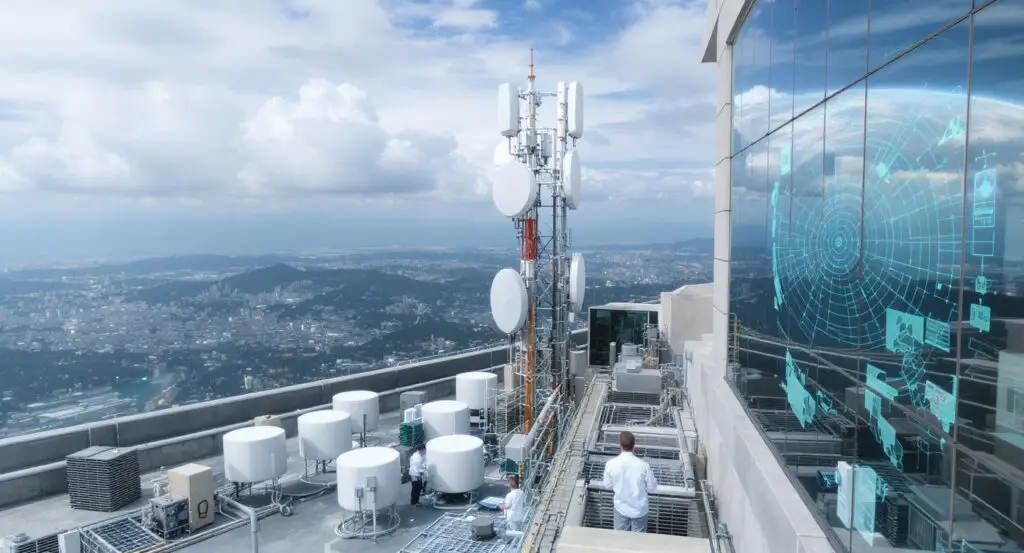A new whitepaper from 5G Americas reveals that the upcoming 6G mobile standard is being built around a groundbreaking technology called Integrated Sensing and Communications (ISAC). This innovation is poised to transform national mobile infrastructures into colossal, real-time radar systems. ISAC operates on principles similar to traditional radar: a mobile mast emits a standard radio signal that then reflects off objects in the surrounding environment. By meticulously comparing the original signal with the returning echo, the network can precisely determine an object’s shape, size, speed, and exact location, even for “passive” objects not connected to the network.
How ISAC Works: Monostatic and Collaborative Modes
ISAC’s functionality extends to both individual and collaborative operations. In ‘monostatic’ mode, a single mobile mast acts autonomously, both transmitting and receiving the radio signals itself. Alternatively, masts can work in concert, with one transmitting the signal and others receiving the reflections. This collaborative approach allows for the creation of a richer and far more detailed picture of the surrounding environment, enhancing the network’s sensing capabilities. Viet Nguyen, President of 5G Americas, highlighted this transformative aspect, stating, “ISAC is a transformative technology that combines radar-like sensing with traditional communications, turning wireless networks into intelligent infrastructure capable of perceiving the physical world.”
Unlocking High-Value Applications Beyond Wi-Fi Sensing
While similar sensing concepts have been explored in home Wi-Fi systems for applications like intruder detection, scaling this capability to a national 5G or 6G network unlocks a new realm of powerful, high-value applications. These applications, which previously necessitated expensive and specialized equipment, can now be integrated directly into the ubiquitous mobile infrastructure. This inherent advantage positions ISAC as a crucial component for the success of 6G, promising to generate new revenue streams and accelerate the adoption of this next-generation standard across various industries.
From Drone Detection to Environmental Monitoring
The transformative possibilities enabled by a “seeing” network are extensive. One of the most frequently discussed applications is in defense and security, specifically for detecting and tracking Uncrewed Aerial Vehicles (UAVs), or drones. The ability to establish safe transport corridors for commercial drones or identify unauthorized ones in restricted airspace presents a significant business opportunity. Beyond tracking objects, ISAC could evolve into a powerful tool for large-scale environmental monitoring, providing instant rainfall data by measuring how radio waves scatter off raindrops, or offering early flood warnings by detecting rising water levels in urban and natural environments.
Diverse Applications Across Modern Life
The potential applications of ISAC touch nearly every facet of modern life. It could optimize traffic flow at busy intersections, enabling emergency services to plan the fastest and safest routes. In indoor settings like factories, ISAC could precisely track automated vehicles, while in airports, it could monitor passenger flow for efficiency and security. Even in hospitals, this technology could offer critical assistance by detecting if a patient has experienced a fall, providing immediate alerts. Amitava Ghosh, Nokia Fellow and a key contributor to the report, noted, “ISAC development is a cornerstone for enabling context-aware services and digital twin technologies in 6G. It also opens the door for carriers to offer advanced, data-driven services that improve safety, streamline automation, and support next-generation mobility.”
Monetizing the “Sixth Sense”: Sensing-as-a-Service
For mobile operators, the commercial viability of this new “sixth sense” is paramount. The report highlights “Sensing-as-a-Service” as the most exciting prospect for monetizing ISAC. In this model, network providers would evolve into data brokers for the physical world. They would not only generate their own sensing information but also combine it with data from other sources, such as public cameras, weather stations, or vehicle sensors, through a process known as sensor fusion. This aggregated and processed information could then be sold to third-party developers and applications, envisioning scenarios like real-time dangerous road condition alerts or pinpoint accurate fleet tracking for logistics firms.
Overcoming Challenges and Looking to the Future
Despite the immense potential, the journey to fully implement ISAC is not without its hurdles. Engineers face the complex challenge of designing a single radio signal capable of simultaneously handling both super-fast communications and high-resolution sensing without compromising either function. Furthermore, significant privacy concerns loom large; a network capable of tracking movements and activities could be perceived as a vast surveillance tool if not managed with robust security measures and clear, fair regulations to earn public trust. Nevertheless, the development journey has already commenced, with standards bodies actively working on ISAC and several companies demonstrating working proofs of concept using existing 5G hardware, signaling a future where networks connect us and intelligently interact with the world.























